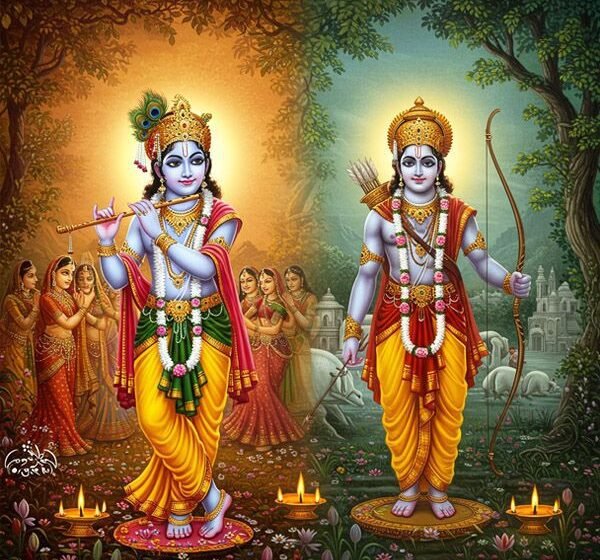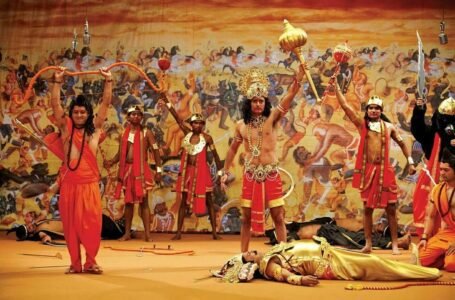Sri Raghava Yadhaveeyam: A Bidirectional Gem of Sanskrit Poetry

-Anushka Sengupta
“Sri Raghava Yadhaveeyam” is an extraordinary bidirectional poem (also called anuloma-viloma kavya) composed by Sri Venkatadhvari, a 17th-century Sanskrit poet and devotee of Lord Vishnu. What makes this composition so unique is that it tells two entirely different stories—the Ramayana and the Bhagavata (life of Krishna)—depending on the direction in which it is read. When read forward (anuloma), it narrates the story of Lord Rama; when read backwards (viloma), it tells the story of Lord Krishna (Yadava).
This ingenious literary construction not only showcases the poet’s command over Sanskrit grammar, but also reveals a deeply integrated theological worldview where Rama and Krishna, both incarnations of Vishnu, are seen as fundamentally one and the same. The poem consists of 30 shlokas (verses), each constructed so carefully that the one and the same verse can be read both ways—each direction telling grammatically correct and semantically meaningful stories.
This is not a linguistic parlor game but a homage to Sanskrit’s structural pliancy, where compound words (samasa), conjugations and syllable counts are used to encode double entendres. For example, a term of Rama’s heroism in forward reading might characterize Krishna’s trickery on the reverse.
The dual narrative operates on several levels, historical, metaphorical, and theological, beautifully fusing the two incarnations of Vishnu into a non-dualistic bhakti.
The central theme of the poem is the unity of Vishnu’s incarnations. While Rama and Krishna appear in different yugas and have opposing temperaments, Rama is the perfect, ascetic monarch, Krishna the mischievous, metaphysical deity, the poem asserts that godhood’s beyond story. This echoes the Advaita Vedanta tradition, in which ultimate reality is non-dual (advaita) and all forms are manifestations of the one Supreme Being.
Venkatadhvari, a Sri Vaishnava, applies the poem as a theological metaphor to show that all divine narratives lead to the same place, just as the poem’s directions.
From a literary perspective, Sri Raghava Yadhaveeyam is a tour de force of Sanskrit poetics (kāvya). It employs devices such as: Anuloma-Viloma (Palindrome Narrative): Entire verses are palindromic in idea, not just in letters; Double Entendre (Shlesha): Multiple meanings packed into the same word or phrase depending on direction or interpretation. and Bhakti Rasa: The aesthetic of devotion is dominant throughout the poem, regardless of the reading direction.
Only a language as structurally rich as Sanskrit allows for such high-order wordplay, and few poets have attempted, let alone succeeded, in composing at this level of intricacy. Far less famous than Valmiki’s Ramayana or Vyasa’s Bhagavatam, Sri Raghava Yadhaveeyam nevertheless enchanted Sanskrit cognoscenti for generations as a poetic wonder. In recent times, it has become celebrated among students of Sanskrit, Indology and comparative mythology for its blend of poetic innovation and theological profundity. It’s frequently analyzed with other Sanskrit palindrome poems and deemed a gleaming illustration of the classical Indian literary tradition’s boundless expressive potential.
Sri Raghava Yadhaveeyam is not just a poetic puzzle. It’s a devotional tour de force that both teases and moves those fortunate to encounter its harmonious complexity, spiritual depth and philosophical subtlety. Venkatadhvari’s genius wasn’t just in his poetry, but in his spirituality, which saw no distinction between Rama and Krishna, or past and future, or left and right. By this he urges his readers to transcend dualisms and drown themselves in the limitless unity of god.
Sri Raghava Yadhaveeyam is a remarkable example of Sanskrit verse by Sri Venkatadhvari, a 17th century poet and Vishnu-devotee. What’s special about this poem is that it reads in both directions. Read on, it’s the story of Raghava (Lord Rama). It paints Yadava (Lord Krishna). That’s what makes it a rare anuloma-viloma kavya, or ‘reverse-order poem’. Though ceremonially ornate, the poem is theologically and emotionally consistent in both directions, offering not only verbal genius but religious passion.
In the early stanzas, the poem unfolds the godly births of Rama and Krishna. Rama comes into the world in Ayodhya to King Dasharatha, the epitome of dharma and royal duty, whereas Krishna is born in Mathura under threat from Kamsa, the epitome of divine incarnation and leela. These twin origins underscore both avatars as distinct manifestations of the same deity. Rama’s narrative is more restrained and duty-bound, versus Krishna’s playful and philosophical tone, both avatars incarnate the supreme Vishnu and uphold virtue.
The middle stanzas of the poem delve into the defining moments of each avatar. Rama’s lessons from Vishwamitra and marriage to Sita echo Krishna’s childhood exploits and his Rasaleela with Radha and the gopis. Here, the poem implicitly contrasts dharma-based love with divine leela, illustrating how both ends celebrate sacred union. The poet’s genius is that on every line there is room for pictures and words to fit both the saint and the faun, the abbot and the lover.
Exile, political challenge, and confrontation with evil are the turning point of both stories. Rama’s forest exile and war with Ravana parallel Krishna’s exile from Mathura, establishment of Dwaraka and involvement in the Mahabharata. These incidents have a shared leitmotif of cosmic justice, where both incarnations lead mankind through turmoil and war, demonstrating the supremacy of dharma over adharma. In either case, the hero’s deeds are not mere personal quests, but world-shaping acts of human salvation.
In the later years, Rama and Krishna both fulfilled their earthly missions and abdicated this mortal coil. Rama enters the Sarayu river. Krishna is pierced by an arrow and returns to the divine. The poem ends in spiritual dissolution of the body into timeless truth. Here our poet highlights a classic Vedantic point—that all form is maya and that the divine is nameless formless beyond, whether Rama or Krishna.
What’s so remarkable about Sri Raghava Yadhaveeyam is not merely that it is reversible, how it theologically reunites Rama and Krishna. The poem fits with the Sri Vaishnava tradition, that all the avatars of Vishnu are versions of the one, eternal god. The poem is a tour de force in shlesha (double meaning) and Sanskrit symmetry, demanding profound expertise in grammar, meter, and poetics. Each line is a linguistic mirror, reflecting two sides of the same sacred tale.
In other words, Sri Raghava Yadhaveeyam is not just a poetic feat. It’s a philosophical reflection on the oneness of god, the strength of language, and the grace of Sanskrit philosophy. Through its intertwined storytelling, it reassures us that the road to truth may be traveled in opposite ways, but both arrive at the same mystical core. It is a reminder of how craft and faith can intertwine, producing an immortal work that still captivates academics, philologists, and spiritual pilgrims.


